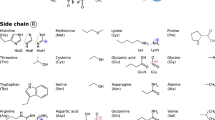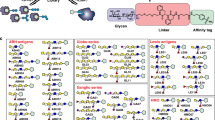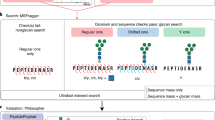Abstract
The energetics of protein–carbohydrate interactions, central to many life processes, cannot yet be manipulated predictably. This is mostly due to an incomplete quantitative understanding of the enthalpic and entropic basis of these interactions in aqueous solution. Here, we show that stereoelectronic effects contribute to stabilizing protein–N-glycan interactions in the context of a cooperatively folding protein. Double-mutant cycle analyses of the folding data from 52 electronically varied N-glycoproteins demonstrate an enthalpy–entropy compensation depending on the electronics of the interacting side chains. Linear and nonlinear models obtained using quantum mechanical calculations and machine learning explain up to 79% and 97% of the experimental interaction energy variability, as inferred from the R2 value of the respective models. Notably, the protein–carbohydrate interaction energies strongly correlate with the molecular orbital energy gaps of the interacting substructures. This suggests that stereoelectronic effects must be given a greater weight than previously thought for accurately modelling the short-range dispersive van der Waals interactions between the N-glycan and the protein.

This is a preview of subscription content, access via your institution
Access options
Access Nature and 54 other Nature Portfolio journals
Get Nature+, our best-value online-access subscription
$29.99 / 30 days
cancel any time
Subscribe to this journal
Receive 12 print issues and online access
$259.00 per year
only $21.58 per issue
Buy this article
- Purchase on Springer Link
- Instant access to full article PDF
Prices may be subject to local taxes which are calculated during checkout






Similar content being viewed by others
Data availability
All data generated or analysed during this study are included in this paper and its Supplementary Information.
Code availability
All of the analysis done in this study was carried out using previously published codes. No custom code was generated during the current study.
References
Hebert, D. N., Lamriben, L., Powers, E. T. & Kelly, J. W. The intrinsic and extrinsic effects of N-linked glycans on glycoproteostasis. Nat. Chem. Biol. 10, 902–910 (2014).
Varki, A. Biological roles of glycans. Glycobiology 27, 3–49 (2016).
Banks, D. D. The effect of glycosylation on the folding kinetics of erythropoietin. J. Mol. Biol. 412, 536–550 (2011).
Lynch, C. J. & Lane, D. A. N-linked glycan stabilization of the VWF A2 domain. Blood 127, 1711–1718 (2016).
Ressler, V. T. & Raines, R. T. Consequences of the endogenous N-glycosylation of human ribonuclease 1. Biochemistry 58, 987–996 (2019).
Tan, N. Y. et al. Sequence-based protein stabilization in the absence of glycosylation. Nat. Commun. 5, 3099 (2014).
Yuzwa, S. A. et al. Increasing O-GlcNAc slows neurodegeneration and stabilizes tau against aggregation. Nat. Chem. Biol. 8, 393–399 (2012).
Chang, M. M. et al. Small-molecule control of antibody N-glycosylation in engineered mammalian cells. Nat. Chem. Biol. 15, 730–736 (2019).
Elliott, S. et al. Enhancement of therapeutic protein in vivo activities through glycoengineering. Nat. Biotechnol. 21, 414–421 (2003).
Laughrey, Z. R., Kiehna, S. E., Riemen, A. J. & Waters, M. L. Carbohydrate−π interactions: what are they worth? J. Am. Chem. Soc. 130, 14625–14633 (2008).
Chaffey, P. K. et al. Structural insight into the stabilizing effect of O-glycosylation. Biochemistry 56, 2897–2906 (2017).
Chen, M. M. et al. Perturbing the folding energy landscape of the bacterial immunity protein Im7 by site-specific N-linked glycosylation. Proc. Natl Acad. Sci. USA 107, 22528–22533 (2010).
Gavrilov, Y., Shental-Bechor, D., Greenblatt, H. M. & Levy, Y. Glycosylation may reduce protein thermodynamic stability by inducing a conformational distortion. J. Phys. Chem. Lett. 6, 3572–3577 (2015).
Woods, R. J. Predicting the structures of glycans, glycoproteins and their complexes. Chem. Rev. 118, 8005–8024 (2018).
Culyba, E. K. et al. Protein native-state stabilization by placing aromatic side chains in N-glycosylated reverse turns. Science 331, 571–575 (2011).
Price, J. L., Powers, D. L., Powers, E. T. & Kelly, J. W. Glycosylation of the enhanced aromatic sequon is similarly stabilizing in three distinct reverse turn contexts. Proc. Natl Acad. Sci. USA 108, 14127–14132 (2011).
Ardejani, M. S., Powers, E. T. & Kelly, J. W. Using cooperatively folded peptides to measure interaction energies and conformational propensities. Acc. Chem. Res. 50, 1875–1882 (2017).
Gao, J. M., Bosco, D. A., Powers, E. T. & Kelly, J. W. Localized thermodynamic coupling between hydrogen bonding and microenvironment polarity substantially stabilizes proteins. Nat. Struct. Mol. Biol. 16, 684–690 (2009).
Hudson, K. L. et al. Carbohydrate–aromatic interactions in proteins. J. Am. Chem. Soc. 137, 15152–15160 (2015).
Hsu, C.-H. et al. The dependence of carbohydrate-aromatic interaction strengths on the structure of the carbohydrate. J. Am. Chem Soc. 138, 7636–7648 (2016).
Chen, W. et al. Structural and energetic basis of carbohydrate–aromatic packing interactions in proteins. J. Am. Chem. Soc. 135, 9877–9884 (2013).
García-Hernández, E. et al. Structural energetics of protein–carbohydrate interactions: insights derived from the study of lysozyme binding to its natural saccharide inhibitors. Protein Sci. 12, 135–142 (2003).
Fox, J. M. et al. The molecular origin of enthalpy/entropy compensation in biomolecular recognition. Annu. Rev. Biophys. 47, 223–250 (2018).
Krug, R. R., Hunter, W. G. & Grieger, R. A. Statistical interpretation of enthalpy–entropy compensation. Nature 261, 566–567 (1976).
Qian, H. & Hopfield, J. J. Entropy–enthalpy compensation: perturbation and relaxation in thermodynamic systems. J. Chem. Phys. 105, 9292–9298 (1996).
Sharp, K. Entropy—enthalpy compensation: fact or artifact? Protein Sci. 10, 661–667 (2001).
Bigman, L. S. & Levy, Y. Entropy–enthalpy compensation in conjugated proteins. Chem. Phys. 514, 95–105 (2018).
Grunwald, E. & Steel, C. Solvent reorganization and thermodynamic enthalpy–entropy compensation. J. Am. Chem. Soc. 117, 5687–5692 (1995).
Hassan, S. A. Implicit treatment of solvent dispersion forces in protein simulations. J. Comput. Chem. 35, 1621–1629 (2014).
Zhong, D., Pal, S. K. & Zewail, A. H. Biological water: a critique. Chem. Phys. Lett. 503, 1–11 (2011).
Yang, L., Adam, C., Nichol, G. S. & Cockroft, S. L. How much do van der Waals dispersion forces contribute to molecular recognition in solution?. Nat. Chem. 5, 1006–1010 (2013).
Grimme, S. Density functional theory with London dispersion corrections. WIREs Comput. Mol. Sci. 1, 211–228 (2011).
Hermann, J., DiStasio, R. A. & Tkatchenko, A. First-principles models for van der Waals interactions in molecules and materials: concepts, theory and applications. Chem. Rev. 117, 4714–4758 (2017).
Wagner, C. et al. Non-additivity of molecule-surface van der Waals potentials from force measurements. Nat. Commun. 5, 5568 (2014).
Frisch, M. J. et al. Gaussian 09, Revision A.2 (Gaussian, 2009).
Pang, S.-K. Quantum-chemically-calculated mechanistically interpretable molecular descriptors for drug-action mechanism study—a case study of anthracycline anticancer antibiotics. RSC Adv. 6, 74426–74435 (2016).
Lu, T. & Chen, F. Quantitative analysis of molecular surface based on improved marching tetrahedra algorithm. J. Mol. Graph. Model. 38, 314–323 (2012).
Murray, J. S. et al. Statistically-based interaction indices derived from molecular surface electrostatic potentials: a general interaction properties function (GIPF). J. Mol. Struct. THEOCHEM 307, 55–64 (1994).
Pham, T.-L. et al. Learning structure–property relationship in crystalline materials: a study of lanthanide–transition metal alloys. J. Chem. Phys. 148, 204106 (2018).
Li, J. & Zhang, R.-Q. Strong orbital interaction in a weak CH–π hydrogen bonding system. Sci. Rep. 6, 22304 (2016).
Perras, F. A. et al. Observation of CH⋅⋅⋅π interactions between methyl and carbonyl groups in proteins. Angew. Chem. Int. Ed. 56, 7564–7567 (2017).
Iwata, S. Dispersion energy evaluated by using locally projected occupied and excited molecular orbitals for molecular interaction. J. Chem. Phys. 135, 094101 (2011).
Kapuy, E. & Kozmutza, C. Calculation of the dispersion interaction energy by using localized molecular orbitals. J. Chem. Phys. 94, 5565–5573 (1991).
Ardejani, M. S. & Orner, B. P. Obey the peptide assembly rules. Science 340, 561–562 (2013).
Jalali-Heravi, M., Shahbazikhah, P., Zekavat, B. & Ardejani, M. S. Principal component analysis-ranking as a variable selection method for the simulation of 13C nuclear magnetic resonance spectra of xanthones using artificial neural networks. QSAR Comb. Sci. 26, 764–772 (2007).
Schaftenaar, G. & de Vlieg, J. Quantum mechanical polar surface area. J. Comput. Aided Mol. Des. 26, 311–318 (2012).
Breiman, L. Random forests. Mach. Learn. 45, 5–32 (2001).
Plevin, M. J., Bryce, D. L. & Boisbouvier, J. Direct detection of CH/π interactions in proteins. Nat. Chem. 2, 466–471 (2010).
Glendening, E. D., Landis, C. R. & Weinhold, F. Natural bond orbital methods. WIREs Comput. Mol. Sci. 2, 1–42 (2012).
Frisch, M. J. et al. Gaussian 16, Revision C.01 (Gaussian, 2016).
Baerends, E. J. et al. ADF2017 (SCM, Vrije Universiteit, 2014).
Patera, L. L., Queck, F., Scheuerer, P. & Repp, J. Mapping orbital changes upon electron transfer with tunnelling microscopy on insulators. Nature 566, 245–248 (2019).
Bartlett, G. J., Choudhary, A., Raines, R. T. & Woolfson, D. N. n → π* interactions in proteins. Nat. Chem. Biol. 6, 615–620 (2010).
Acknowledgements
This work was funded by grants GM51105 (J.W.K.) and GM100934 (L.N.) from the National Institutes of Health. The authors thank G. J. Kroon and J. Dyson for their help with the protein NMR experiments, D. E. Mortenson for help with the chemical synthesis experiments, K. N. Houk, M. Jäger and D. E. Mortenson for helpful discussions, J.-C. Ducom and W. Han for help with the computational infrastructure and C. Fearns and K. Lee for critical reading of the manuscript.
Author information
Authors and Affiliations
Contributions
M.S.A., L.N., E.T.P. and J.W.K. conceived and designed the experiments. M.S.A. carried out the experiments and performed the data analysis. M.S.A., L.N., E.T.P. and J.W.K. co-wrote the paper. Correspondence and requests for materials should be addressed to J.W.K.
Corresponding author
Ethics declarations
Competing interests
The authors declare no competing interests.
Additional information
Peer review information Nature Chemistry thanks Christopher Bauer and the other, anonymous, reviewer(s) for their contribution to the peer review of this work.
Publisher’s note Springer Nature remains neutral with regard to jurisdictional claims in published maps and institutional affiliations.
Supplementary information
Supplementary Information
Supplementary Figs. 1–49, Methods and Table 1.
Supplementary Data 1
Experimental values and quantum mechanical descriptors used for machine learning.
Rights and permissions
About this article
Cite this article
Ardejani, M.S., Noodleman, L., Powers, E.T. et al. Stereoelectronic effects in stabilizing protein–N-glycan interactions revealed by experiment and machine learning. Nat. Chem. 13, 480–487 (2021). https://doi.org/10.1038/s41557-021-00646-w
Received:
Accepted:
Published:
Issue Date:
DOI: https://doi.org/10.1038/s41557-021-00646-w
This article is cited by
-
Transferable prediction of intermolecular coupling achieved by hierarchical material representation
Science China Materials (2023)
-
The glycosylation in SARS-CoV-2 and its receptor ACE2
Signal Transduction and Targeted Therapy (2021)



